Algorithmic Investigation of Complex Dynamics Arising from High-Order Nonlinearities in Parametrically Forced Systems
Abstract
1. Introduction
1.1. The Damped Mathieu Cubic–Quintic Duffing Oscillator
1.2. Research Gaps and Contributions
- Most existing work does not explicitly employ a comprehensive suite of established chaos detection techniques to fully characterize the dynamical behavior of complex nonlinear oscillators.
- Many studies assume a perfectly known model, often overlooking the application of modern data-driven methods to discover the governing equations of such oscillators from time-series data alone.
- While bifurcation behavior is often discussed, a systematic and quantitative analysis of how parameters like damping control the various routes to chaos is not always present.
- We present the first comprehensive stability diagram for the DM-CQDO in the forcing amplitude and frequency parameter space, clearly mapping the boundaries between periodic, quasiperiodic, and chaotic regimes.
- We identify the period-doubling cascade as the primary route to chaos and quantitatively demonstrate how its onset is controlled by the systems damping coefficient through a detailed bifurcation analysis.
- Through a data-driven discovery framework, we validated the governing equations and confirmed the dominant influence of the cubic nonlinearity and the parametric forcing terms in shaping the system’s complex dynamical response.
- We also performed a careful study of the inherent multi-stability of the system with the aid of quantitative Lyapunov analysis and graphical constraints of the fractal organization of attractor basin boundaries. Notably, the suggested workflow is not restricted to the DM-CQDO, which this research takes into consideration. All of these components, i.e., sparse model discovery, bifurcation analysis, Lyapunov exponent calculation, spectral diagnostics, recurrence mapping, and basin classification, have been formulated within a generalizable framework that can be readily applied to a wide range of nonlinear systems, such as electronic circuits, MEMS/NEMS, and biological oscillators. This building block architecture makes the method more reliable and adaptable, making it a general diagnostic platform and not a case-specific procedure.
2. Identifying the System Dynamics
2.1. Algorithm
- Data collection: First, time-series data for the system’s state variables are collected. For a system with states , we form a data matrix . The time derivatives are also required and are typically computed numerically from the data, forming a derivative matrix .
- Candidate function library construction: A library, , of candidate nonlinear functions is constructed. This library contains potential terms that might appear in the governing equations. In the case of the oscillator analysis, the library of candidate functions was built to contain both the poly terms (e.g., ) and the trigonometry terms (e.g., ) by making sure the basis functions capture the necessary nonlinear and parametric characteristics of the system.
- Sparse regression: The core of SINDy is solving the linear system for the coefficient matrix . Crucially, SINDy assumes that the governing equations are sparse, meaning only a few terms in the library are active. To find this sparse set of coefficients, we employed the sequentially thresholded least-squares (STLSQ) algorithm. This iterative method solves for and then sets any coefficients with a magnitude smaller than a predefined threshold to zero, repeating until the solution converges.
- Model reconstruction: The non-zero values of coefficient matrix determine the active terms of the system. This choice provides a set of differential equations and is short and open to interpretation; further, this choice best describes the behavior found in the data.
2.2. System Simulation
2.3. Model Identification and Comparison
2.3.1. Phase Analysis
2.3.2. Time-Series Fidelity
3. Global Behavior and Stability Analysis
3.1. Bifurcation Analysis
3.1.1. General Trend: The Stabilizing Effect of Damping
3.1.2. Detailed Analysis of Dynamic Regimes
- Case 1: Low amplitude (): At low damping values (e.g., and ), the system suddenly and almost explosively switches to broadband chaotic behavior at a comparatively low excitation frequency (). The resulting chaotic attractor is of a large range of values. The parametric forcing is easily capable of injecting enough energy to overcome the restoring forces of the system with minimal energy dissipation, to permit the trajectories to explore a very large, complex region of phase space and support very high-amplitude chaotic oscillations.
- Case 2: Moderate amplitude (): For the diagram for , the system is known to undergo a canonical period-doubling cascade, a familiar cause of chaos. At first, there is a period-1 limit cycle. At a bifurcation point (), as is exceeded, this orbit becomes unstable and forms a period-2 orbit, which is represented in the bifurcation diagram as the branching of one branch into two. Additional bifurcations of are successive bifurcations, with the period-2 orbit bifurcating into period-4, period-8, etc. This cascade proceeds until the number of periods essentially goes to infinity, at which point the system exhibits aperiodic chaotic behavior.
- Case 3: High amplitude (): With increased damping, the chaos transition is smoother and organized. To achieve a period-doubling cascade, the major route is still the period-doubling cascade, but it now begins with larger excitation frequencies (), and its overall extent of chaotic motion is smaller. This action underlines the stabilizing influence of the damping being enhanced that smothers the scale and the amount of the chaotic dynamics.
3.1.3. Quantitative Summary of Transitions
3.2. Stability Diagrams in the Parameter Space
- Case (a): Low damping () At low damping, the parameter space is dominated by a vast dominant chaotic sea that emerges at even moderate excitation amplitudes. The regions of periodic behavior are confined to a narrow periodic tongue and are quickly overwhelmed by chaos as the forcing amplitude increases. This global view corresponds to the abrupt transition to chaos observed in the one-dimensional bifurcation diagram for low damping.
- Case (b): Intermediate damping () As damping increases, the chaotic region recedes significantly, and the stable resonance tongues become much larger and more clearly defined. This shows that a larger forcing amplitude is now required to induce chaos. Critically, the boundary between the chaotic and periodic regions is no longer simple; it is a sharp and complex fractal bifurcation boundary, representing the loci of the period-doubling bifurcations that lead to chaos.
- Case (c): High damping () At high damping, the system is almost entirely stable and predictable, with the parameter space being a predominantly stable region. Chaos has been strongly suppressed, now confined to small, isolated islands of chaos that only appear at very high forcing amplitudes.
3.3. Lyapunov Exponent
- Case 1: Low-amplitude initial condition: In the first case of the condition (0.01, 0.01, 0.01), the maximum Lyapunov exponent is (). The positive value authenticates chaotic behavior, where small perturbations increase exponentially with time. Figure 5a indicates that the () is positive post initial transients, which proves the existence of a chaotic attractor.
- Case 2: Medium-amplitude initial condition: Having the initial condition of medium amplitude (0.3, 0.3, 0.3), the system is more chaotic with a larger Lyapunov exponent () (Figure 5b). This amplified value displays sensitivity to an initial condition and a more rapid separation of adjacent paths, indicating a stronger instability about this initial condition.
- Case 3: High-amplitude initial condition: In the case of the high-amplitude initial condition (0.5, 0.5, 0.5), the largest Lyapunov exponent is negative, (Figure 5c) and the trajectories do tend to approach a non-chaotic, steady-state attractor. This constant reduction in the exponent by time, which is indicated by the figure, is a confirmation of the same result.Quantitative evidence of multi-stability is the existence of the positive and negative largest Lyapunov exponents, which are obtained using the same system parameters; the multi-stable dynamical system is one in which both chaotic and stable attractors appear at the same time.
3.4. Multi-Stability
3.4.1. Analysis Based on Figure 6
- Figure 6a: This figure uses two initial conditions to show the difference between chaotic and periodic behaviors. The initial values for the first curve are , and for the second curve they are . The first curve shows very packed loops, while the second set of initial conditions results in regular, repeating loops that show stable oscillations. In time, both sets develop chaotic motion, revealing that small variations in the initial conditions greatly influence the system.
- Figure 6b: A similar comparison between different attractors shows that the system still exhibits multi-stable behavior. With initial values of (0.3, 0.12), both periodic and chaotic behaviors are seen on the trajectory. When the system has multiple attractors, both orderly and disorderly regions begin to form, and the phase portrait explains how the system switches quickly between them.
- Figure 6c: This is a different combination of initial conditions () used in Curve 1 and there is a displaced version in Curve 2. Both of the scenarios suggest that the system is sensitive to the initial data. Curve 1 represents bigger variations and distinct dispersion. Curve 2 starts off constrained but turns into a thicker structure, demonstrating how sensitive pushes may cause various attractor basins to emerge. This demonstrates that the further the initial conditions are displaced from the origin, less regularity is clear and there is more chaotic movement.
- Figure 6d: This exploration is executed with a shift set to 0.4. The trajectories demonstrate that there is a greater difference between attractor behaviors. Curve 1 (coral) has a wide multi-lobed attractor, which is folded. Curve 2 (olive) begins as periodic, but then moves on to be a distinct chaotic attractor. A pair of different orbits in the phase space shows that there are two chaotic attractors of the same physical parameters.
- Figure 6e: The graphs with are fully disordered and have no apparent periodic structures. The coral path is passing across a greater space, indicating a higher level of energy or more sensitivity. The olive path exhibits several nested areas; this means that it can be trapped several times in the local wells on its way outwards. Since dynamical behavior of the two plots has repeated merging of attractors, it appears that strange attractors are the major regulator of the dynamics.
- Figure 6f: This figure shows the system response using another perturbed initial condition, , which is a significant departure in the trajectories. The trajectory (Curve 1) covers a large area of the phase space with loose, jagged loops, which is a sign of a fully developed chaotic attractor. Contrary to this, the olive trajectory (Curve 2) remains closer to the local area, creating a more compact, tight structure. This comparison brings out the multi-stable system.
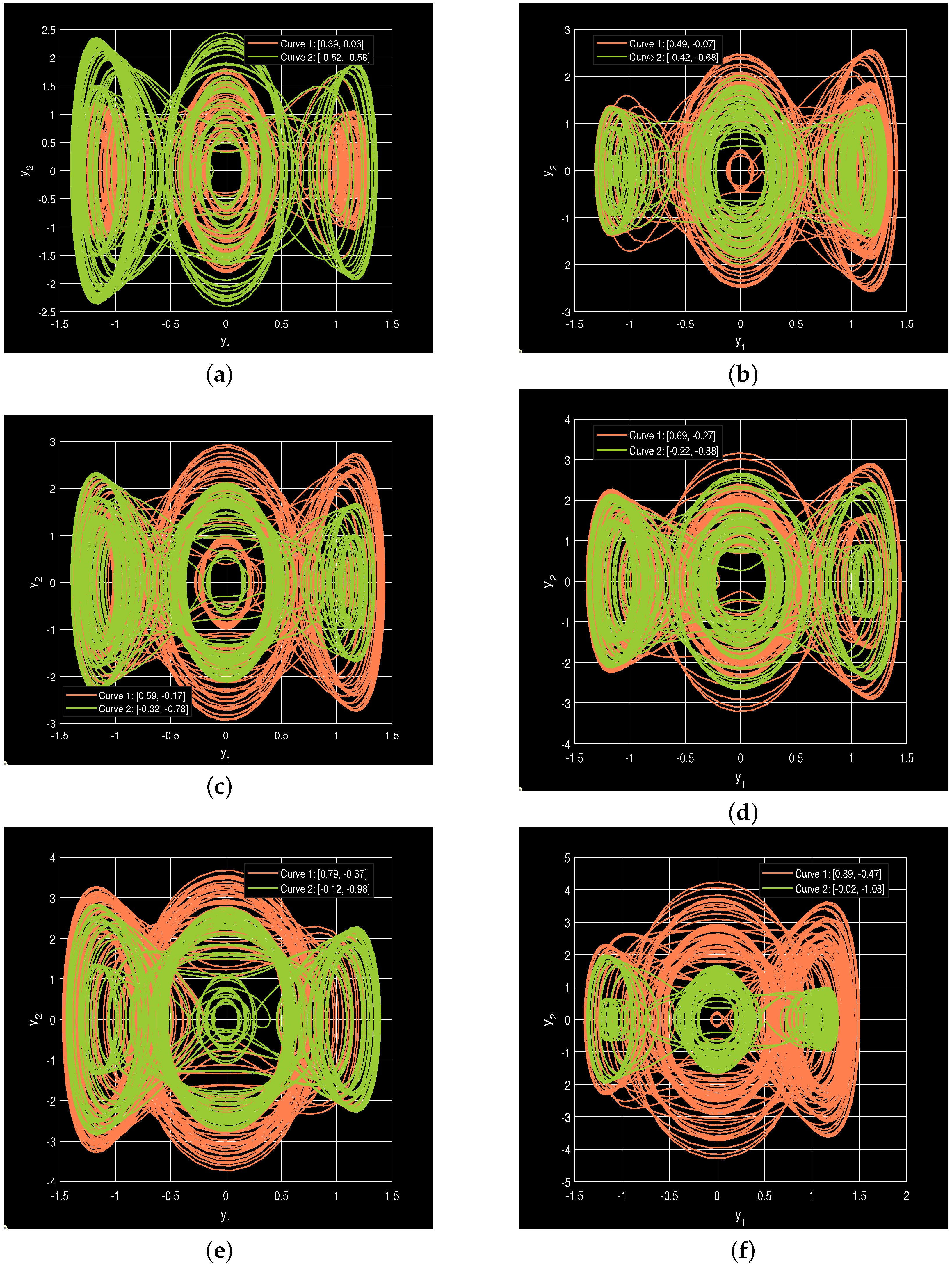
3.4.2. Analysis Based on Figure 7
- Figure 7a: The dynamical responses exhibit multi-stability when parameters are changed to have the value of . The magenta curve (Curve 1), with the initial condition of [0.39, 0.03], looks like a broad, erratic-looking object. The yellow curve (Curve 2) that originates at [−0.52, −0.58] is extremely localized, consisting of a tight, dense attractor. This dramatic difference in geometry depicts how sensitive the system is to initial conditions.
- Figure 7b: With slightly perturbed initial conditions of [0.49, −0.07] for Curve 1 and [−0.42, −0.68] for Curve 2, the trajectories evolve into attractors which overlap partly. Curve 1 is tilted more to the left side of the phase space, with Curve 2 having a concentration of loops that are spread out better to the right. Such trajectories emphasize the important role of even tiny variations in initial conditions, as the effect is asymmetric.
- Figure 7c: The points begin from (0.59, −0.17) and (−0.32, −0.78), and the trend is the same. The numerous attractors indicate that the system is in a constant state of changing between ordered and chaotic based on the initial state of the system. This can be much like the classical chaotic systems, where the slightest change in factors can cause a system to shift to an alternate attractor type.
- Figure 7d: By changing the initial point to (0.69, −0.27) and (−0.22, −0.88), the attractors are more densely represented with multiple points of loop cross-over. The two trajectories remain in the fixed regions, but because they have different shapes, they indicate a transition between one stability regime to another. Its crowded loops indicate that the system is probably alternating between quasi-periodic and weakly chaotic dynamics and has coexisting attractors.
- Figure 7e: The orbits, i.e., those with starting point (0.79, −0.37) and (−0.12, −0.98), appear to be less organized in the phase space. The magenta group has most of the loops on the left and the yellow group stretches more on the right. This means that even a slight alteration in the initial position may result in a quite different development of systems.
- Figure 7f: This depicts the vector fields of conditions and . The system described after the magenta trajectory is more predictable, whereas the one described by the yellow trajectory is less predictable. This implies that a system may move in almost a repetitive manner or be disorganized depending on the point of beginning. What is indicated by the overlapping and non-overlapping loops is that the system is able to exhibit various behaviors at the same time, which is a characteristic feature of multi-stability.
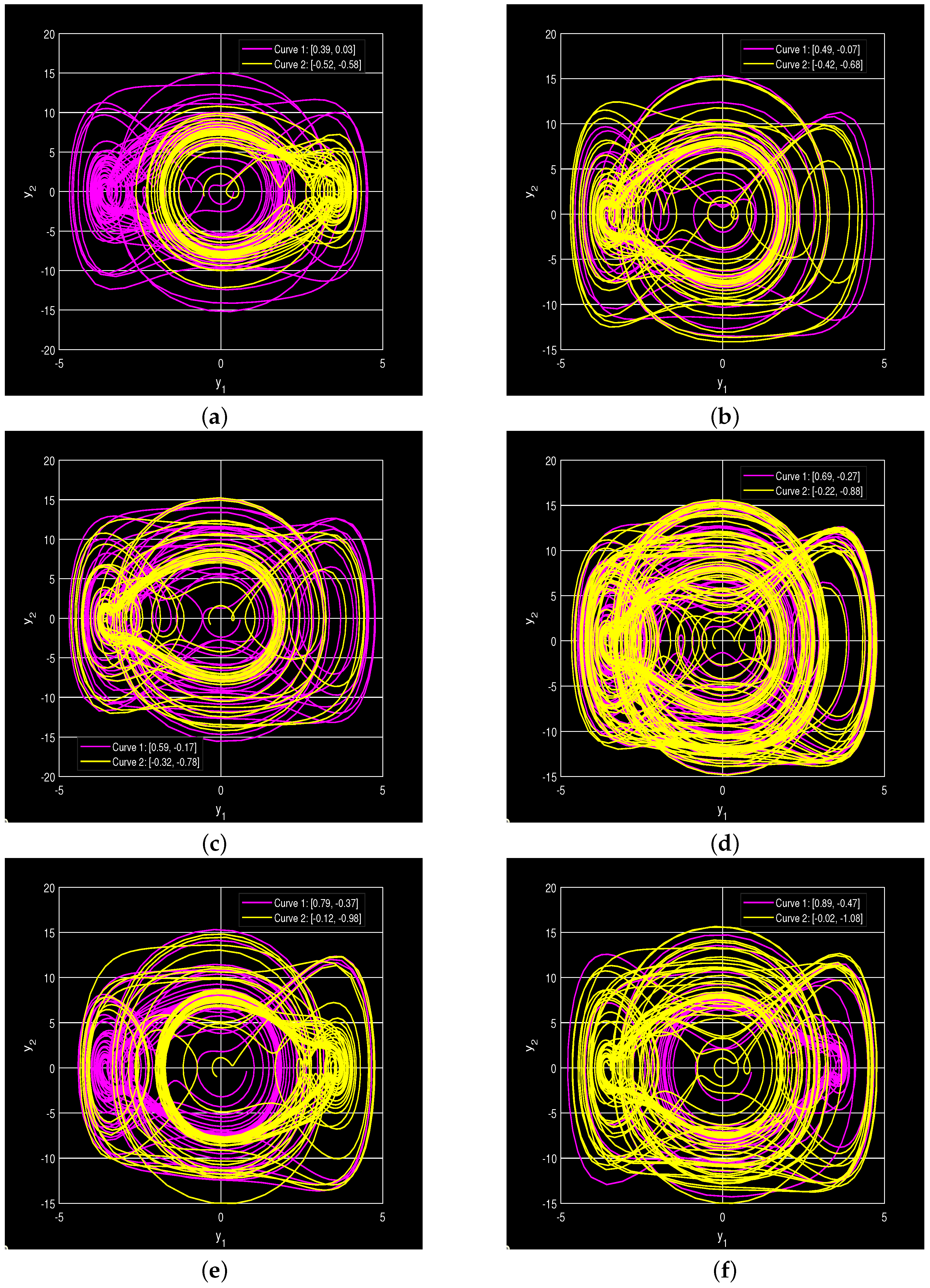
| Algorithm 1: Multi-stability Analysis |
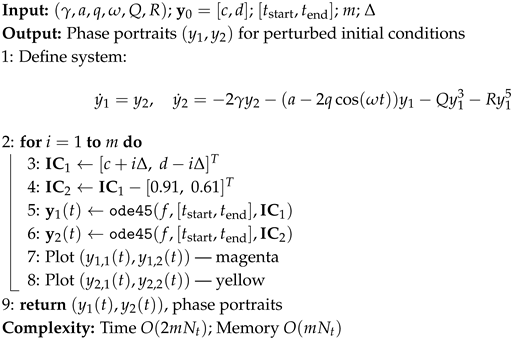 |
3.5. Basin Analysis
- Analysis of Figure 8a: As shown in Figure 8a, a basin with riddled topology means that the attractor regions are closely intertwined. Slight variations in the initial values and can cause the trajectory to look very different, even with everything else fixed. Six alternating colored regions illustrate a riddled basin structure, where results are strongly influenced by starting conditions and can be quite unpredictable. Looking around the central and lower parts of the plot, the lines between the basins have a detailed and fractal pattern, indicating that the system includes chaotic behavior. Such actions align with systems that are influenced by both strong nonlinearity and periodic changes in the environment.
- Analysis of Figure 8b: A slight variation in the initial conditions (keeping unchanged) results in a riddled basin that looks markedly different. Although the global structure still has a stable core, the domain boundaries can move and realign, demonstrating how sensitive the landscape is to tiny fluctuations. This restarts, showing that the limits of the basins are not perfect and revealing that the system stays unpredictable, even when practically the same conditions are used at the start. Chaotic behavior like this appears near important bifurcation points in systems.
- Analysis of Figure 8c: In Figure 8c, the basins appear more broken and less continuous than in the other two figures. A slight change in the initial value of produces attractor figures that are spread out and less uniform. Since the phase space is less cohesive and the colors are arranged randomly, it appears that the system could be close to a chaotic region. The change from a riddled to a scattered basin shows that complexity is higher in the system and that accurate starting conditions are required to avoid uncertainty as time goes on.
- Analysis of Figure 8d: Figure 8d displays a deeply disordered and defective riddled basin landscape. The system has no chance to adjust its fixed parameters or the value of , yet changing and by small amounts results in very different perspectives in the long run. When different colors are seen together within the pattern, it indicates that there are numerous beautiful attractors close together, but the lack of long, continuous colors shows how sensitive to chaos the system can be.
- Analysis of Figure 8e: Figure 8e shows what a basin structure looks like, featuring regions that are only partially coherent. There are slightly more continuous colored regions in the attractor domains than in Figure 8d, hinting at a small change toward areas with local stability. When q increases to 11.0 and d decreases to 0.05, the fractal lines of the basins shift and make some regions more prominent than others. However, the system multi-stability and sensitivity to starting conditions are still present due to its complex filaments and collapsed neighborhoods.
- Analysis of Figure 8f: The pattern in Figure 8f is still riddled, but with much simpler attractor regions than before. The system nonlinearity and slow rate of modulation make it possible for some basins to spread and become dominant in some regions of the initial condition space. But little traces of chaotic filigree and bands of color can still be seen in the phase plot during this phase. There is evidence of a regulating regime that is not yet fully stable, since some of its elements remain truly chaotic.Together, Figure 8a–c make it clear that a modest difference in results in major changes in the way attractor patterns form. It makes clear that the system is very sensitive to its conditions and tends to have unpredictable long-term behavior. Figure 8d–f add further details on how parameters such as nonlinearity depth, external force strength, and frequency range make a difference. The computational method used to generate these basins is detailed in Algorithm 2, and the specific parameters are summarized in Table 4. The set of frames explains how nonlinear systems that see a repeating external force often display dynamic behavior and are very responsive. Such basin areas, full of intricately jumbled areas of similar attractors, show that the system is multi-stable and chaotic. They show that some basins have turned from being enclosed by chaos to being separated by structures, showing signs of stability that replace instability. The presence of chaotic multi-stability and major sensitivity can still be noted, as these figures retain the essential features of riddled or fragmented basins, despite the transitions.
| Algorithm 2: Scattered Basin Classification via RK4 Integration |
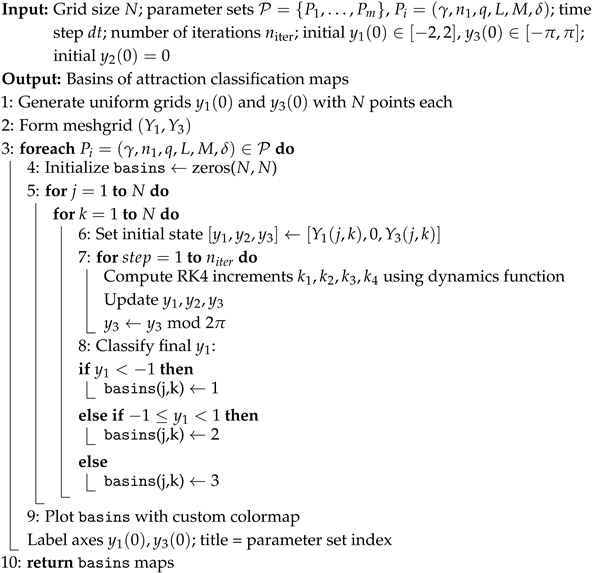 |
4. Attractor Geometry and Phase Space
4.1. Phase Portraits
4.1.1. Effect of Varying Damping Coefficient ()
- Low damping (): When there is a little energy added, small oscillations continue for a relatively long period. The orbits are very broad and curved, which reveals a sluggish reduction in their energy. For this regime, the phase portrait has the potential to demonstrate periodic or chaotic behavior, mainly due to strong nonlinear and forcing effects.
- Moderate damping (): As becomes 0.03, the system works more efficiently to damp complicated modes. The spirals surround each other more closely as the changes converge on a stable-state point. Such a design is nearly at critical damping, helping to avoid overshoot while still permitting damped oscillations.
- High damping (): If equals 0.3 or greater, the system becomes damaged and is dominated by linear dissipative forces rather than by restoration and nonlinear forces. All paths fast approach the origin with very few oscillations. There is no need for complex motions and complex attractors cannot develop. This shows that damping is an option to reduce nonlinear or chaotic motions.
4.1.2. Effect of Varying Natural Frequency ()
- Resonant frequency (): If is close to one and especially close to the excitation frequency, the system becomes susceptible to resonance from the parametric drive. Under this condition, the closed-loop motion seen in the phase space is only possible for Mathieu-type systems at . In this regime, the motion often repeats itself periodically or almost periodically.
- Increased frequency (): With at 1.2, the structure of the phase space becomes more complicated. The presence of loops and unusual swings in paths means that the system is performing nonlinear resonance. The phenomenon of internal resonances or frequency locking is responsible for joining different modes of vibration together. It is also possible that, under the right conditions, this step marks the start of chaotic behavior through quasiperiodicity.
- High frequency (): When , the phase portrait exhibits a densely populated structure, with trajectories no longer forming closed orbits, but instead densely filling extended regions of the phase space. This behavior is indicative of the onset of chaos in the system. Such a transition is characteristic of parametric resonance, wherein the frequency modulation couples with the system natural frequency in a manner that destabilizes its dynamics.
4.1.3. Effect of Varying Nonlinear Coefficients (L and M)
- Weak nonlinearity (): For very small values, there is only a small nonlinear effect, so the system converges to its equilibrium point smoothly. The phase portrait consists of symmetric spirals that look much like those of a damped harmonic oscillator.
- Moderate nonlinearity (): The impact of the coefficients can be seen more clearly at 0.4. The plots reveal that the motions follow looping paths with different thickness and shape, demonstrating the influence of nonlinear stiffening or softening. Sinusoidal motion is interrupted, and the frequency depends on the system amplitude, which is a sign of Duffing-like systems. Nonlinearity in the system starts to change the energy landscape, offering chances for multiple stable states.
- Strong nonlinearity (): With high state values, the nonlinear behaviors become the main factor in the dynamics. The density increases, and the way the phase space is folded supports the idea of chaotic attractors. Here, more than one attractor may exist, so the long-term actions of the system are closely linked to where it starts from. This type of regime shows the effects of riddled basins of attraction, bifurcations, and global instability.
| Parameter (Symbol) | Value | Observed Dynamics | Interpretation |
|---|---|---|---|
| Damping () | 0.003 | Large spiral orbits, transient loops | Weak damping allows complex trajectories and longer energy retention |
| 0.03 | Moderate convergence, reduced loops | Intermediate damping suppresses large excursions | |
| 0.3 | Rapid convergence to origin | Strong damping dominates; motion decays quickly | |
| Frequency () | 1.0 | Regular loops, symmetric trajectories | Resonance with excitation; periodic or quasi-periodic motion |
| 1.2 | Deformed loops, twisting phase paths | Nonlinear resonance; possible mode-mixing | |
| 1.5 | Dense and irregular patterns | Parametric resonance; onset of chaos likely | |
| Nonlinearity () | 0.01 | Smooth convergence, near-linear | System behaves almost linearly |
| 0.4 | Deformed loops, amplitude-modulated paths | Nonlinearities influence amplitude-frequency relations | |
| 1.5 | Dense, chaotic-looking phase space | Strong nonlinear effects dominate, complex or chaotic motion |
| Algorithm 3: Phase Portraits of Nonlinear ODE System |
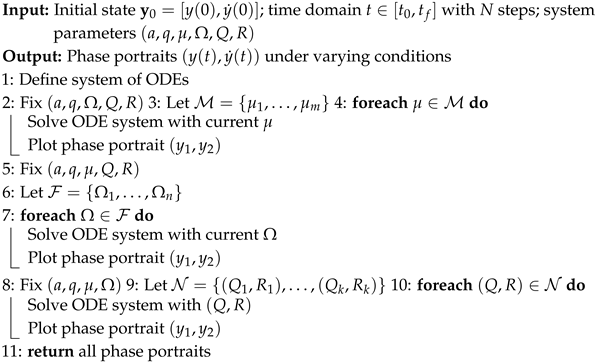 |
4.2. Chaotic Attractor
4.2.1. Analysis of Figure 10a
4.2.2. Analysis of Figure 10b
4.2.3. Analysis of Figure 10c
| Algorithm 4: Attractor Visualization via High-Resolution ODE Integration |
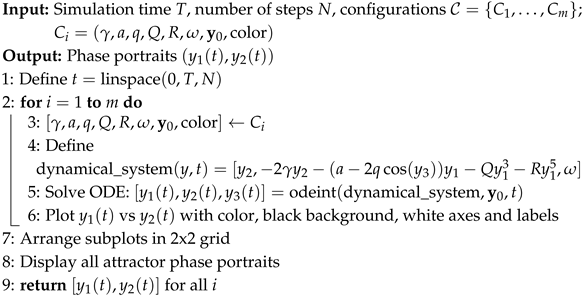 |
4.3. Return Map
Analysis of System Motion by Varying Frequency ()
| Algorithm 5: Return Maps for a Dynamical System |
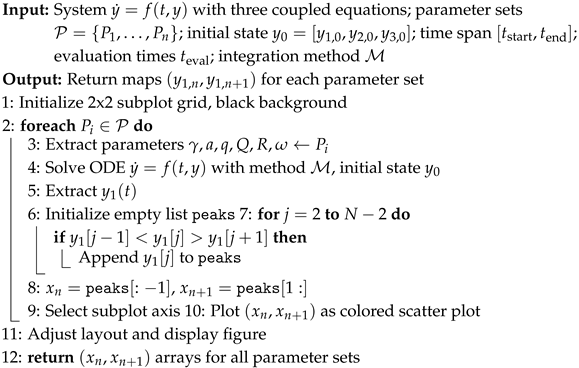 |
5. Spectral and Temporal Properties
5.1. Power Spectrum
- Spectral analysis of Figure 12a: Spectral analysis was applied to three different initial conditions: , , and . At low frequencies (), the three spectra have large power amplitudes which tend to decrease with frequency. The power levels at the intermediate range (), show much more distinct values, with the yellow spectrum containing a more powerful magnitude of power than the magenta and cyan spectra, meaning more mid range frequencies contribute to the spectrum. Beyond () frequencies, all spectra show a decreasing pattern with slight amplitude fluctuations, which are high frequency modes dampened. This general spectral activity highlights the sensitivity of the system’s frequency response to its initial conditions, especially at mid and high frequency regimes.
- Spectral analysis of Figure 12b: The analysis has again been performed under a distinct choice of initial conditions: , , and . As previously noted, the size of the power also decreases with increasing frequency. Nevertheless, in the mid frequency range, the yellow curve exhibits more pronounced oscillatory features, indicating that variations in initial conditions can influence the distribution of energy across different frequency bands. At a high frequency, all curves have a decay pattern which is the same but with slight variations, representing some differences in the system’s high frequency dynamics. These mid range oscillations indicate the existence of some underlying quasi-periodic structures in the primary chaotic attractor.
- Spectral analysis of Figure 12c: This analysis indicates the power distribution of initial conditions , , and . The resultant spectra act in a similar way as the earlier cases, except that the power amplitudes are higher at lower frequencies and tend to diminish at higher frequencies. There is, however, a very clear distinction in the mid range of frequencies, wherein the cyan curve is much lower than the magenta and yellow curve. The other two curves have long-term oscillations, but the yellow curve always has a minor advantage in power. This confirms that not only the direction in the phase space but also the energy distribution over frequencies is extremely sensitive to the starting point of a system, which is a prominent multi-stability property.
| Algorithm 6: Power Spectrum Analysis of Nonlinear ODE System |
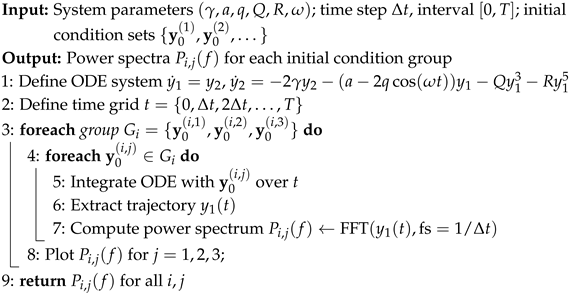 |
5.2. Recurrence Plots
- Analysis of Figure 13a: The pattern observed in the recurrence plot of is not regular and contains interrupted diagonal lines and numerous intricate designs. This implies a complexly behaving system that is very sensitive to the initial conditions. The pattern is not repeated in each and every period due to the lack of long diagonal structures. The texture of the plots resembles a mature chaotic regime. Rather, the changes seem to be influenced by peculiar interactions, and the evolution seems less predictable.
- Analysis of Figure 13b: Unlike the plot of , the plot of has more noticeable patterns and has both diagonal lines and areas enclosed by vertical lines. Thus, there is certain basic periodicity, but the system is influenced by irregular and diffuse outliers. The fact that the recurrences are in a grid formation shows that the system may display quasi-periodicity. This indicates a motion that is more ordered than pure chaos but not perfectly periodic. Frequently, such behavior happens when a system displays weak chaos or if there are interactions.
- Analysis of Figure 13c: The recurrence plot in Figure 13c shows behaving in a way that is different from the others, forming just one long diagonal line. As a result, the motion is fully periodic, with the system repeating the same path over and over. Because scattered recurrence points are missing, the system appears to be stable and without noticeable changes or chaos. This represents the simple, periodic drive of the system.
| Algorithm 7: Recurrence Plots for a 3D Dynamical System |
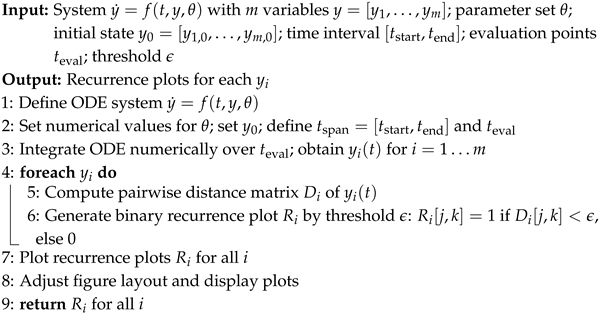 |
6. Conclusions
- Future efforts could focus on developing computationally efficient, high-resolution algorithms capable of resolving the intricate fractal structure of basin boundaries in nonlinear dynamical systems.
- Future efforts could ystematically monitor the development of attractors to automatically identify complex global bifurcations by using parameter continuation algorithms.
- Designing and testing parametric control or delayed feedback algorithms can help manage or suppress the chaotic behavior identified by our framework.
- Enhancing the analysis pipeline with machine learning algorithms can be used to automatically classify different dynamic regimes in real time.
Author Contributions
Funding
Data Availability Statement
Conflicts of Interest
Abbreviations
| SINDy | Sparse Identification of Nonlinear Dynamics |
| DM-CQDO | Damped Mathieu Cubic–Quintic Duffing Oscillator |
| MEMS | Micro-Electro-Mechanical System |
| NEMS | Nano-Electro-Mechanical System |
| PINNs | Physics-Informed Neural Networks |
| STLSQ | Sequentially Thresholded Least-Squares |
| RK4 | Fourth-Order Runge–Kutta |
| RP | Recurrence Plot |
References
- Scanlan, R.H.; Tomko, J.J. Airfoil and bridge deck flutter derivatives. J. Eng. Mech. Div. 1971, 97, 1717–1737. [Google Scholar] [CrossRef]
- Franco, H. Wavelet analysis of a nonlinear oscillator transient during synchronization. Int. J. Bifurcat. Chaos 1996, 6, 2557–2570. [Google Scholar] [CrossRef]
- Matsumoto, T. A chaotic attractor from Chua’s circuit. IEEE Trans. Circuits Syst. 2003, 31, 1055–1058. [Google Scholar] [CrossRef]
- Kovacic, I. On the motion of a generalized van der Pol oscillator. Commun. Nonlinear Sci. Numer. Simul. 2011, 16, 1640–1649. [Google Scholar] [CrossRef]
- Glass, L.; Mackey, M.C. From Clocks to Chaos: The Rhythms of Life; Princeton University Press: Princeton, NJ, USA, 1988. [Google Scholar]
- Slotine, J.J.E.; Li, W. Applied Nonlinear Control; Prentice Hall: Englewood Cliffs, NJ, USA, 1991. [Google Scholar]
- Nayfeh, A.H.; Balachandran, B. Applied Nonlinear Dynamics; Wiley: New York, NY, USA, 1995. [Google Scholar]
- Nayfeh, A.H.; Mook, D.T. Nonlinear Oscillations; John Wiley & Sons: New York, NY, USA, 2024. [Google Scholar]
- Lai, S.K.; Lim, C.W.; Wu, B.S.; Wang, C.; Zeng, Q.C.; He, X.F. Newton-harmonic balancing approach for accurate solutions to nonlinear cubic-quintic Duffing oscillators. Appl. Math. Model. 2008, 33, 852–866. [Google Scholar] [CrossRef]
- Kovacic, I.; Brennan, M.J. The Duffing Equation: Nonlinear Oscillators and Their Behaviour; John Wiley & Sons: New York, NY, USA, 2011. [Google Scholar]
- Rand, R.H. Lecture Notes on Nonlinear Vibrations; Internet-First University Press (Cornell eCommons): Ithaca, NY, USA, 2012. [Google Scholar]
- Cveticanin, L. Homotopy–perturbation method for pure nonlinear differential equation. Chaos Solitons Fractals 2006, 30, 1221–1230. [Google Scholar] [CrossRef]
- Boyd, R.W.; Gaeta, A.L.; Giese, E. Nonlinear optics. In Springer Handbook of Atomic, Molecular, and Optical Physics; Springer: Cham, Switzerland, 2008; pp. 1097–1110. [Google Scholar]
- Akhmediev, N.N.; Ankiewicz, A. Nonlinear Pulses and Beams; Springer: Berlin/Heidelberg, Germany, 1997; pp. 23–43. [Google Scholar]
- Krylov, S.; Maimon, R. Pull-in dynamics of an elastic beam actuated by continuously distributed electrostatic force. J. Vib. Acoust. 2004, 126, 332–342. [Google Scholar] [CrossRef]
- Awrejcewicz, J.; Lamarque, C.H. Bifurcation and Chaos in Nonsmooth Mechanical Systems; World Scientific: Singapore, 2003. [Google Scholar]
- Chakraborty, G.; Jani, N. Nonlinear dynamics of resonant microelectromechanical system (MEMS): A review. Mech. Sci. Way Forw. 2020, 57–81. [Google Scholar]
- Triki, H.; Bouguerra, A.; Gao, X.; Biswas, A.; Yıldırım, Y.; Alshomrani, A.S. Propagation dynamics of nonautonomous solitons in a temporally modulated cubic–quintic–septimal nonlinear medium. Eur. Phys. J. Plus 2024, 139, 1–12. [Google Scholar] [CrossRef]
- Klapa Antonion, X.W.; Raissi, M.; Joshie, L. Machine learning through physics–informed neural networks: Progress and challenges. Acad. J. Sci. Technol. 2024, 9, 2024. [Google Scholar] [CrossRef]
- Ren, Z.; Chen, J.; Wang, T.; Zhang, Z.; Zhao, P.; Liu, X.; Xie, J. Main sub-harmonic joint resonance of fractional quintic van der Pol-Duffing oscillator. Nonlinear Dyn. 2024, 112, 17863–17880. [Google Scholar] [CrossRef]
- Infal, B.; Jhangeer, A.; Muddassar, M. Dynamical patterns in stochastic ρ4 equation: An analysis of quasi-periodic, bifurcation, chaotic behavior. Int. J. Geom. Methods Mod. Phys. 2025, 22, 2450320. [Google Scholar] [CrossRef]
- Nisar, K.S.; Inc, M.; Jhangeer, A.; Muddassar, M.; Infal, B. New soliton solutions of Heisenberg ferromagnetic spin chain model. Pramana 2022, 96, 1–8. [Google Scholar] [CrossRef]
- Lacarbonara, W. Nonlinear Structural Mechanics: Theory, Dynamical Phenomena and Modeling; Springer: Berlin/Heidelberg, Germany, 2013. [Google Scholar]
- He, J.H. The homotopy perturbation method for nonlinear oscillators with discontinuities. Appl. Math. Comput. 2004, 151, 287–292. [Google Scholar] [CrossRef]
- Herişanu, N.; Marinca, V. Explicit analytical approximation to large-amplitude non-linear oscillations of a uniform cantilever beam carrying an intermediate lumped mass and rotary inertia. Meccanica 2010, 45, 847–855. [Google Scholar] [CrossRef]
- He, J.H.; Moatimid, G.M.; Zekry, M.H. Forced nonlinear oscillator in a fractal space. Facta Univ. Ser. Mech. Eng. 2022, 20, 001–020. [Google Scholar] [CrossRef]
- Kuznetsov, Y.A. Elements of Applied Bifurcation Theory; Springer: New York, NY, USA, 1998. [Google Scholar]
- Ganji, S.S.; Barari, A.; Karimpour, S.; Domairry, G. Motion of a rigid rod rocking back and forth and cubic-quintic Duffing oscillators. J. Theor. Appl. Mech. 2012, 50, 215–229. [Google Scholar]
- Ghayesh, M.H.; Amabili, M. Nonlinear vibrations and stability of an axially moving Timoshenko beam with an intermediate spring support. Mech. Mach. Theory 2013, 67, 1–16. [Google Scholar] [CrossRef]
- Gatti, G. A nonlinear quasi-zero stiffness vibration isolator with quintic restoring force characteristic: A fundamental analytical insight. J. Vib. Control 2024, 30, 4185–4198. [Google Scholar] [CrossRef]
- Brunton, S.L.; Proctor, J.L.; Kutz, J.N. Discovering governing equations from data by sparse identification of nonlinear dynamical systems. Proc. Natl. Acad. Sci. USA 2016, 113, 3932–3937. [Google Scholar] [CrossRef]
- Kaheman, K.; Kutz, J.N.; Brunton, S.L. SINDy-PI: A robust algorithm for parallel implicit sparse identification of nonlinear dynamics. Proc. R. Soc. A 2020, 476, 20200279. [Google Scholar] [CrossRef]
- Dawson, S.T.; Brunton, S.L. Improved approximations to Wagner function using sparse identification of nonlinear dynamics. AIAA J. 2022, 60, 1691–1707. [Google Scholar] [CrossRef]
- Raissi, M.; Perdikaris, P.; Karniadakis, G.E. Physics-informed neural networks: A deep learning framework for solving forward and inverse problems involving nonlinear partial differential equations. J. Comput. Phys. 2019, 378, 686–707. [Google Scholar] [CrossRef]
- Lusch, B.; Kutz, J.N.; Brunton, S.L. Deep learning for universal linear embeddings of nonlinear dynamics. Nat. Commun. 2018, 9, 4950. [Google Scholar] [CrossRef]
- Karimov, A.; Kopets, E.; Karimov, T.; Almjasheva, O.; Arlyapov, V.; Butusov, D. Empirically developed model of the stirring-controlled Belousov–Zhabotinsky reaction. Chaos Solitons Fractals 2023, 176, 114149. [Google Scholar] [CrossRef]
- Wolf, A.; Swift, J.B.; Swinney, H.L.; Vastano, J.A. Determining Lyapunov exponents from a time series. Phys. D 1985, 16, 285–317. [Google Scholar] [CrossRef]
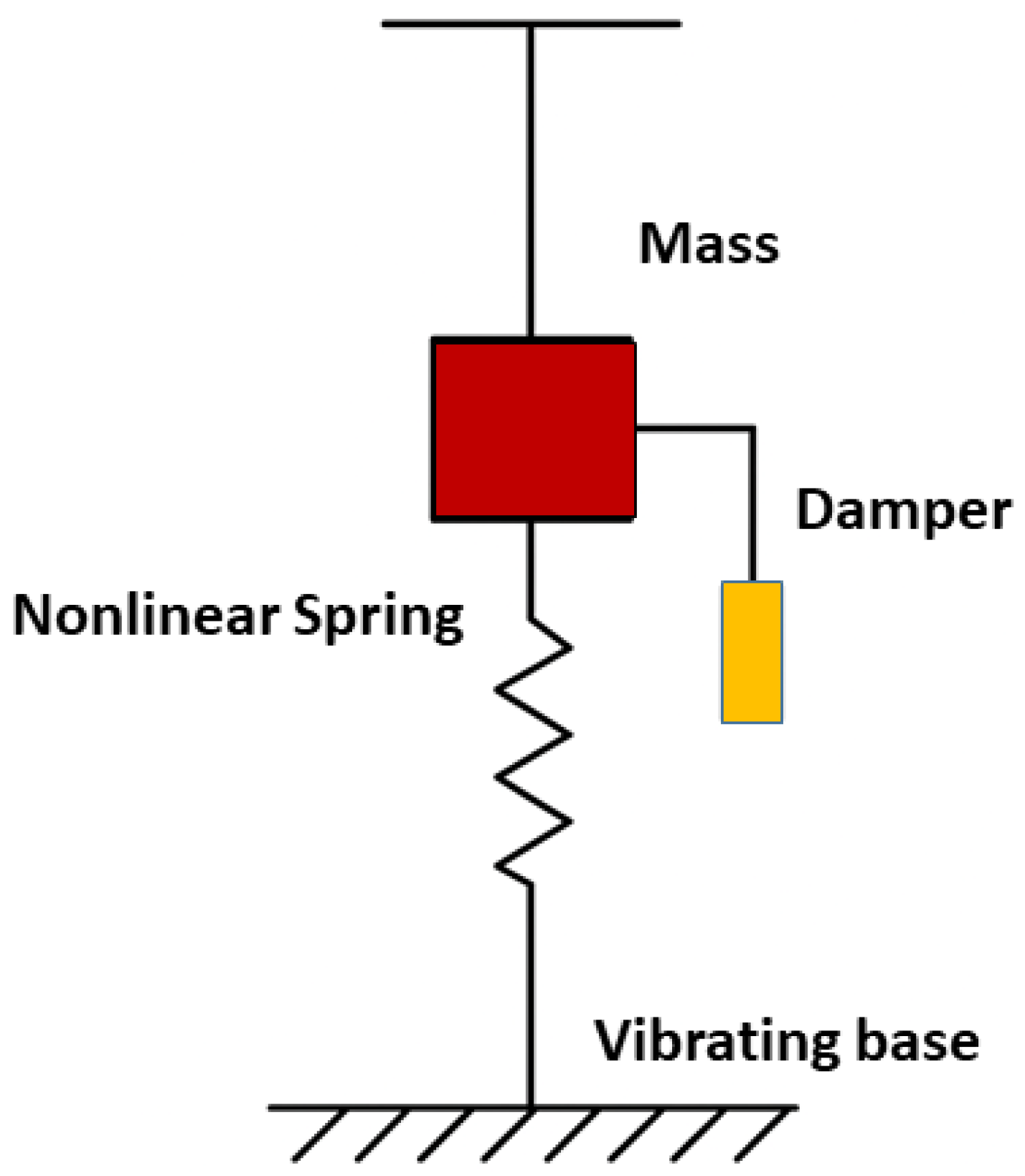
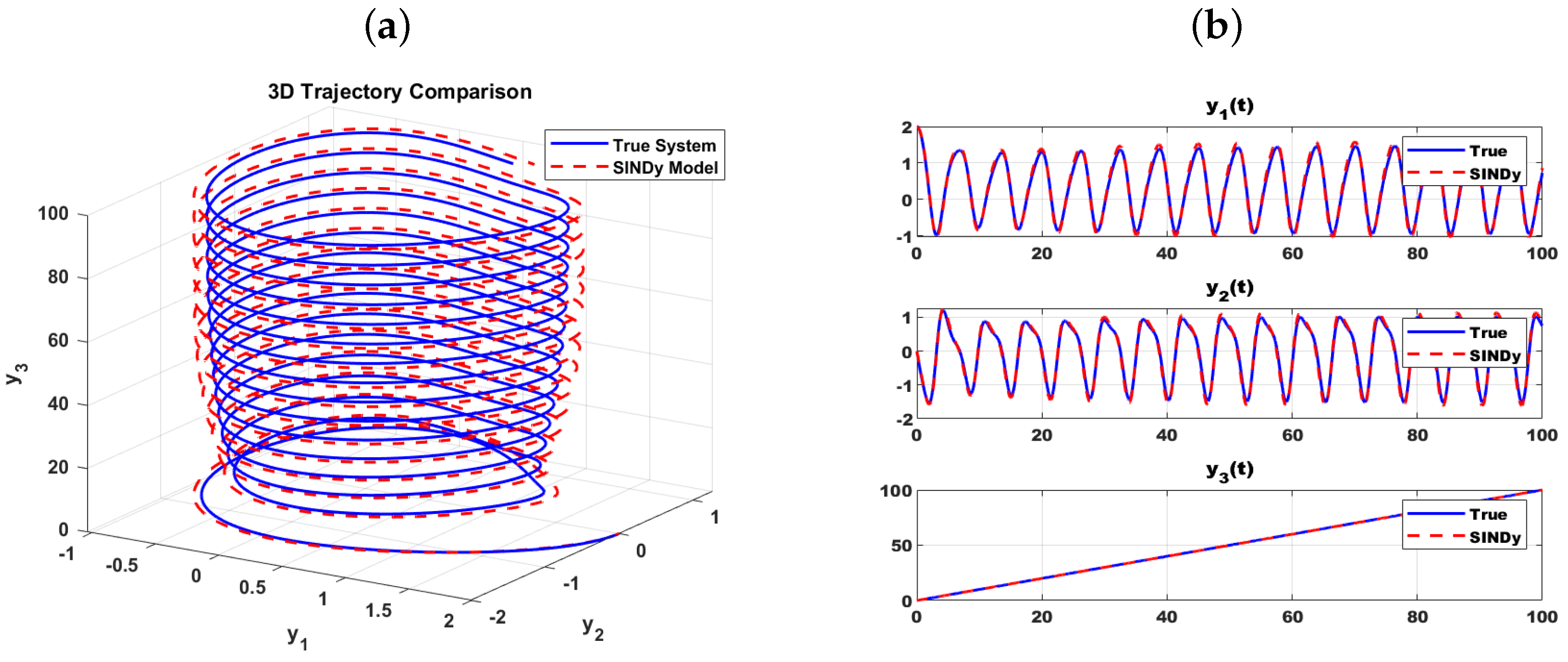
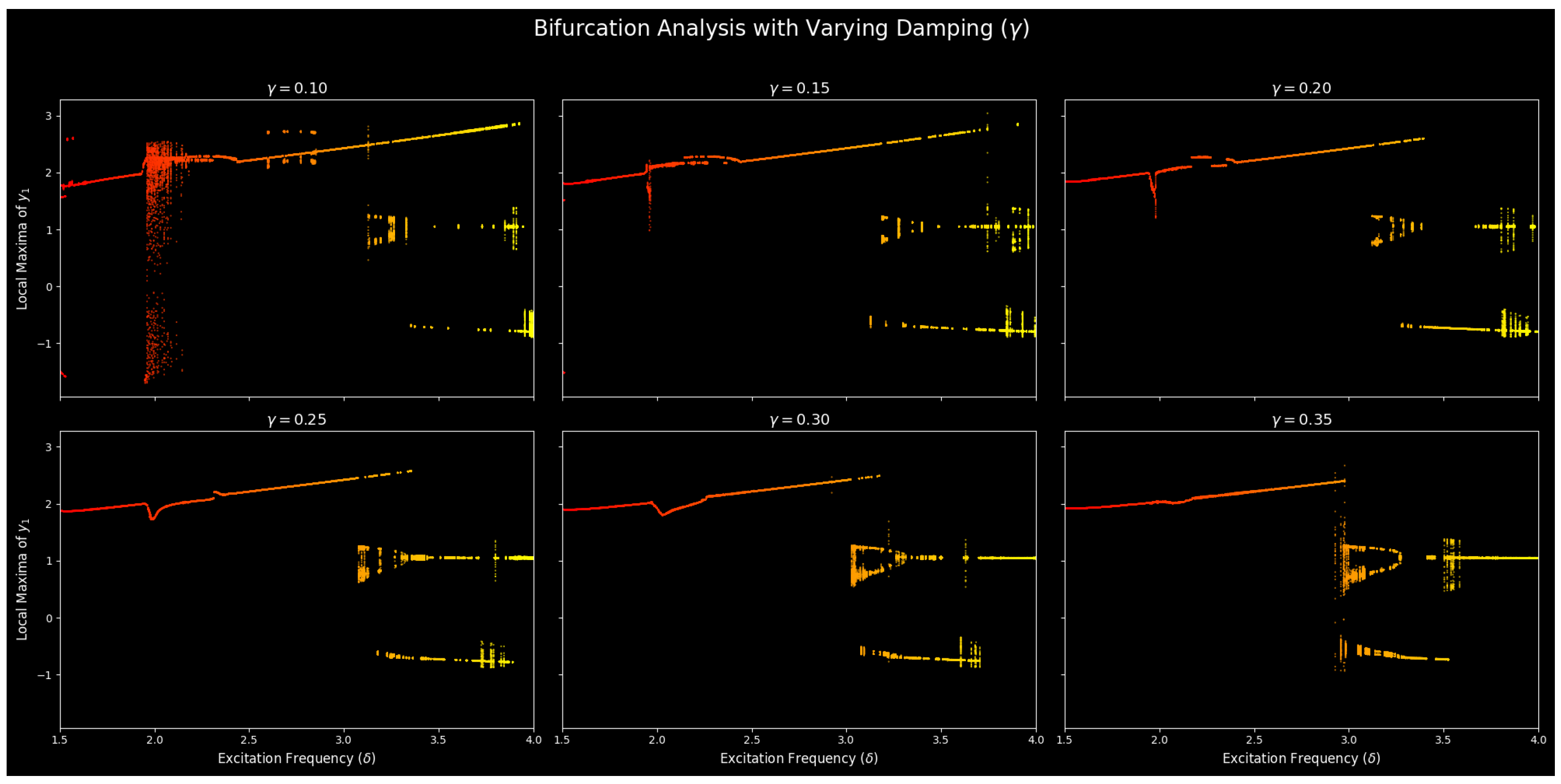
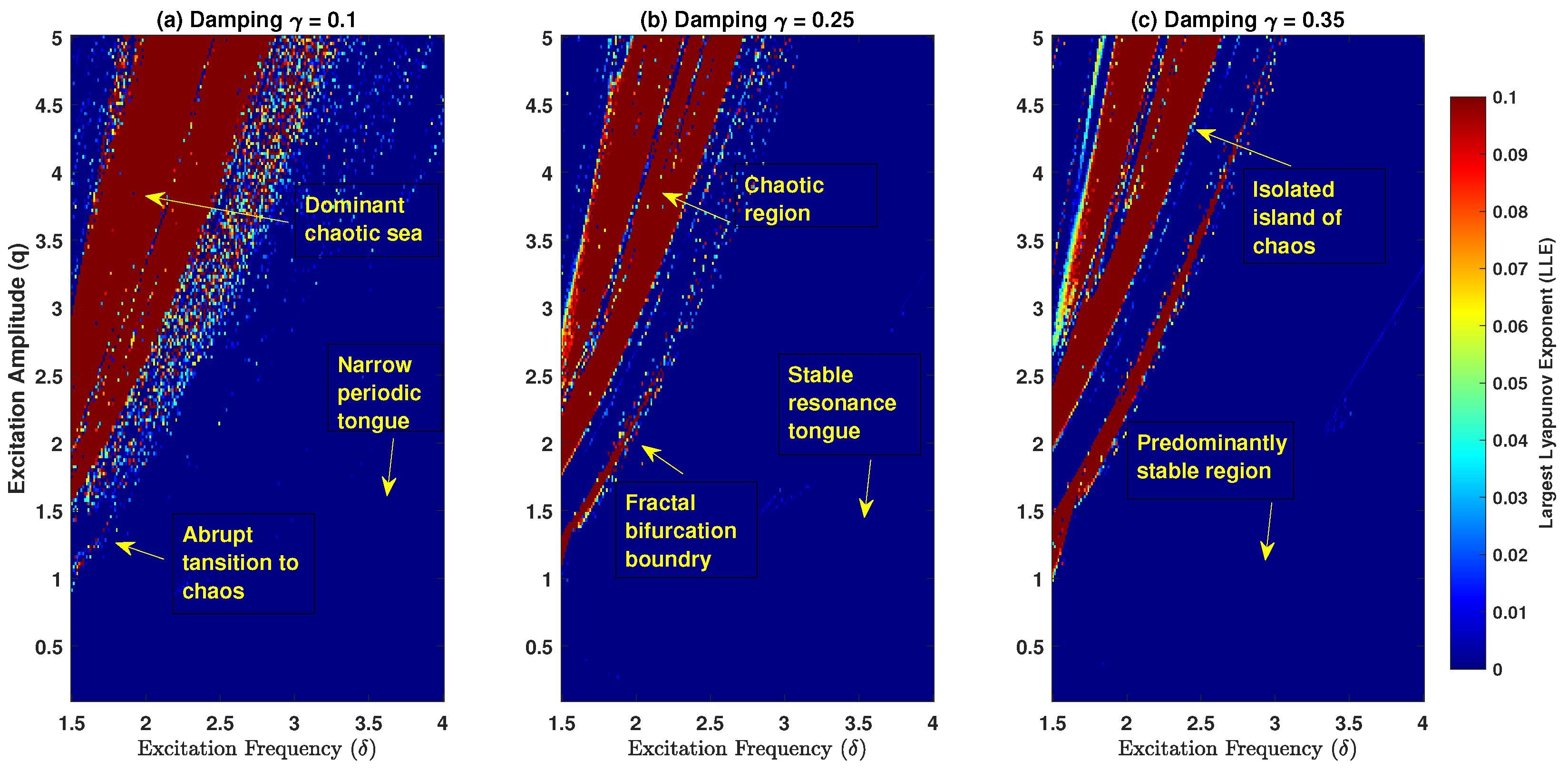
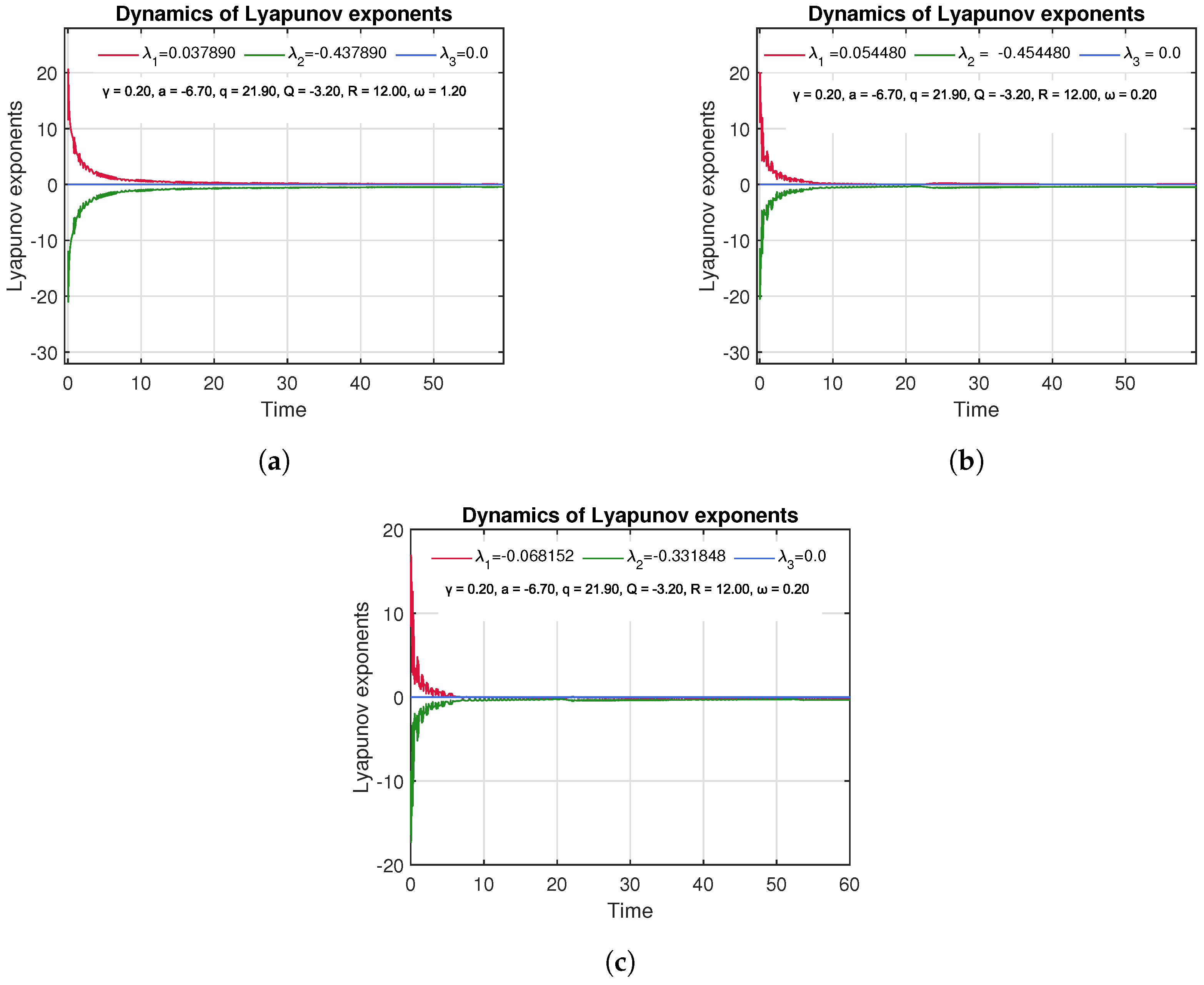
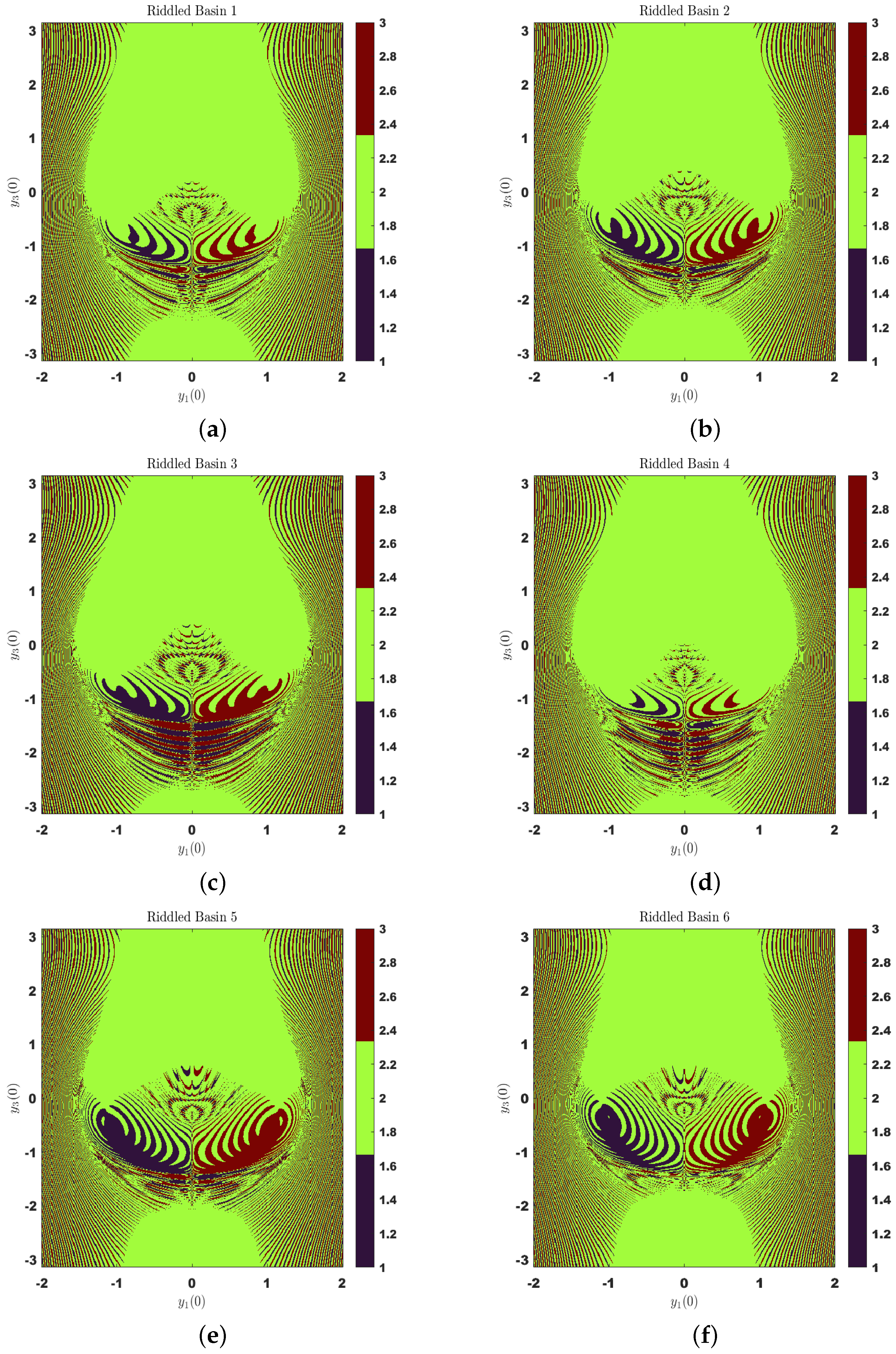
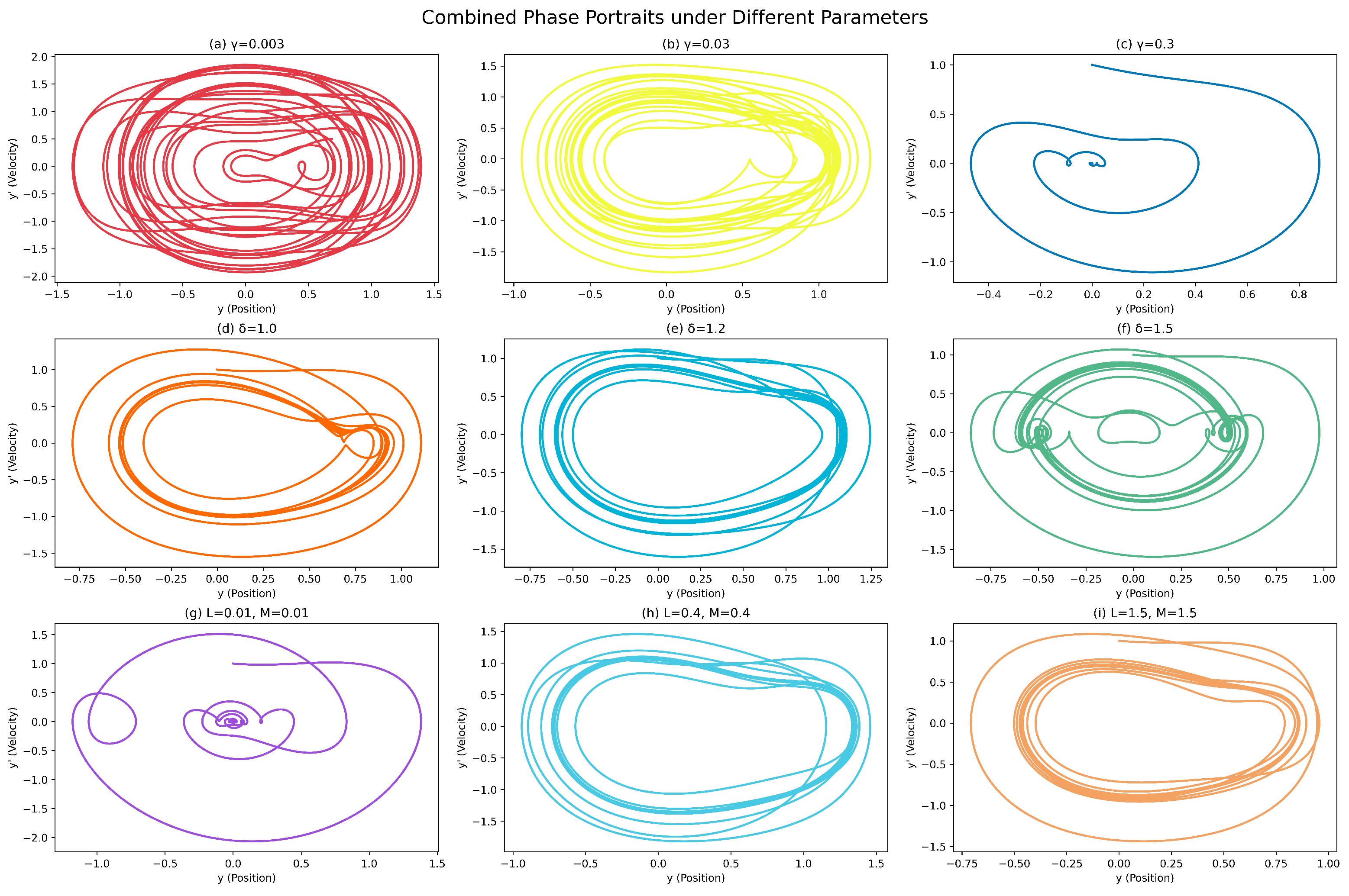
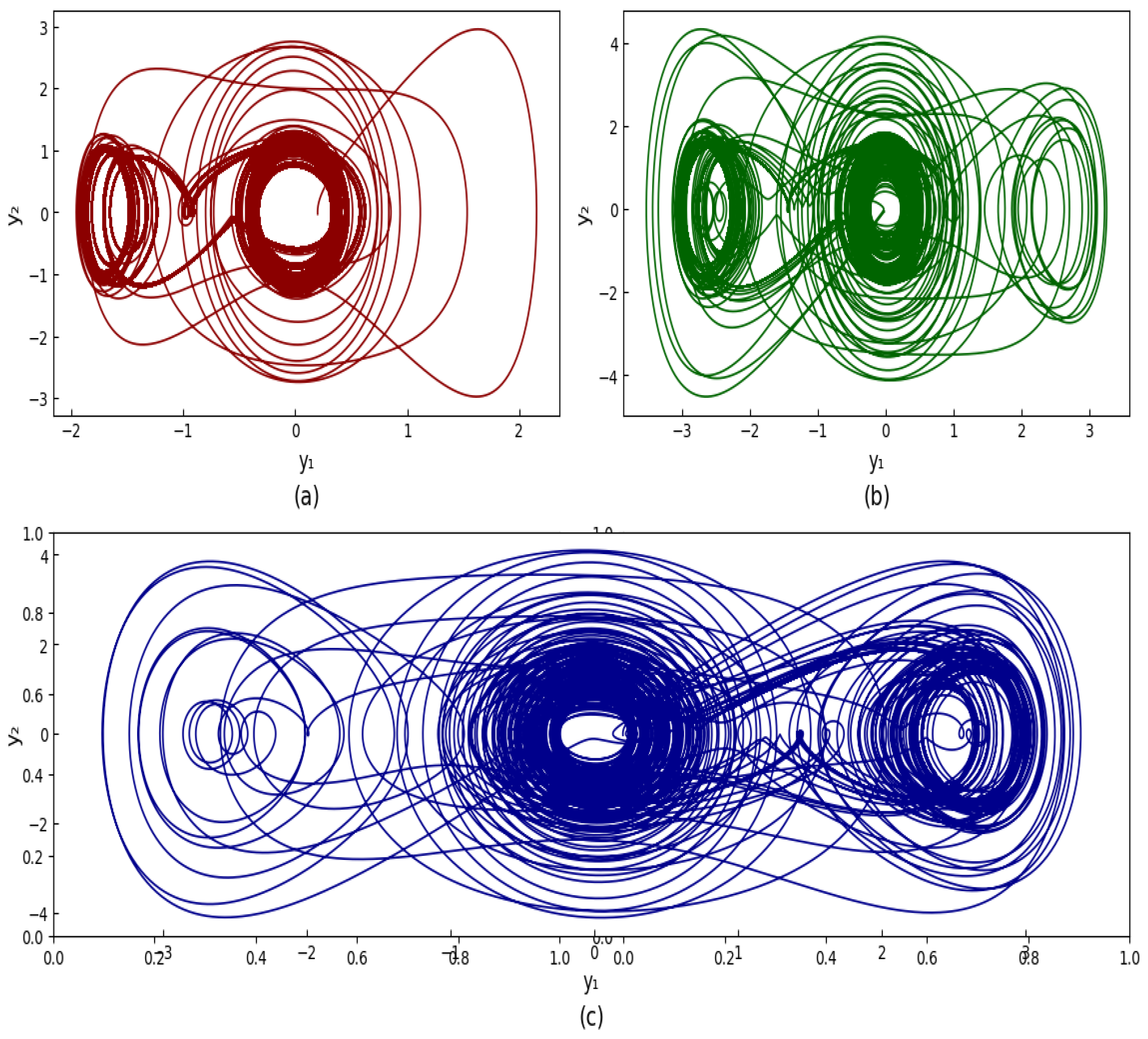
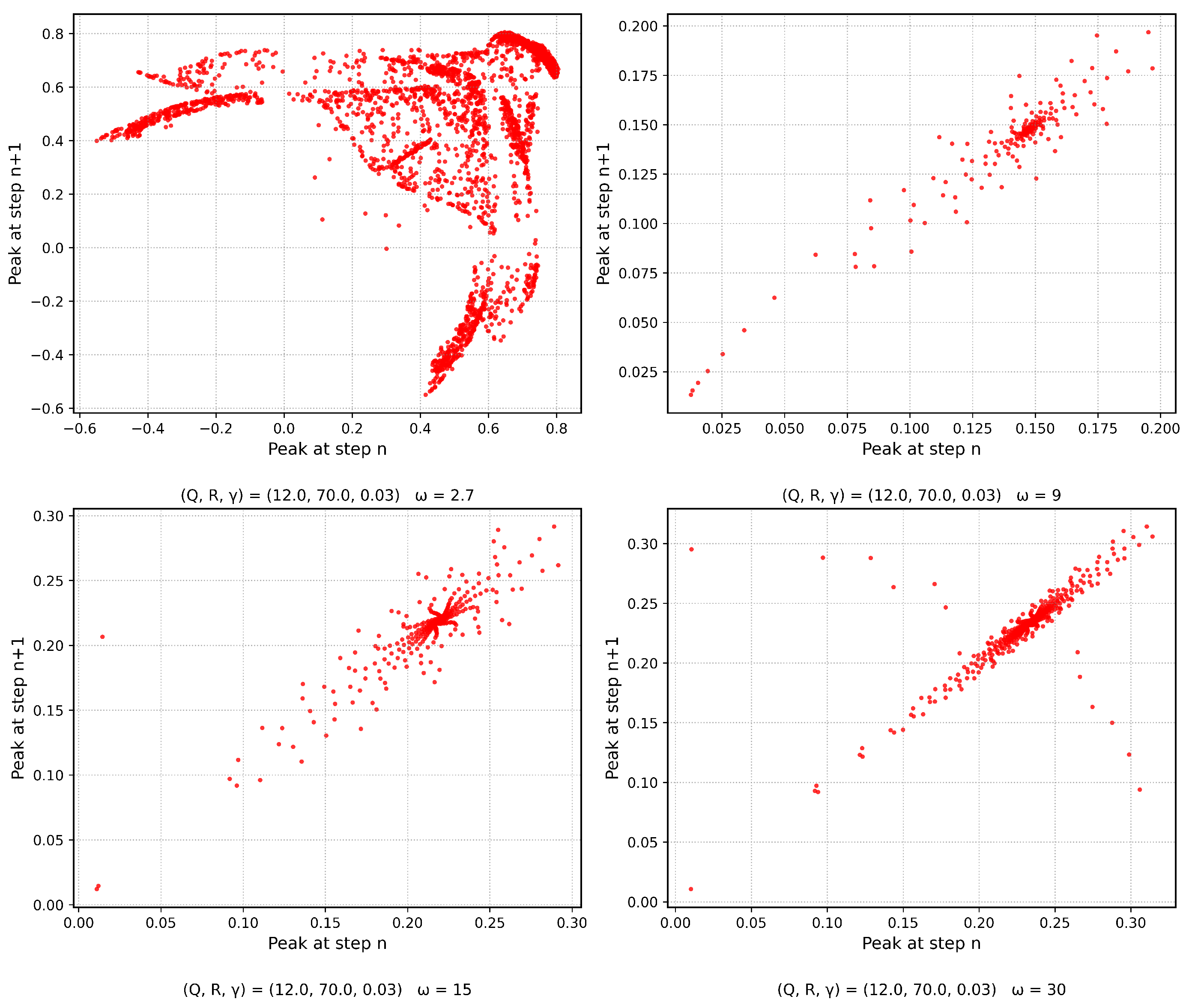
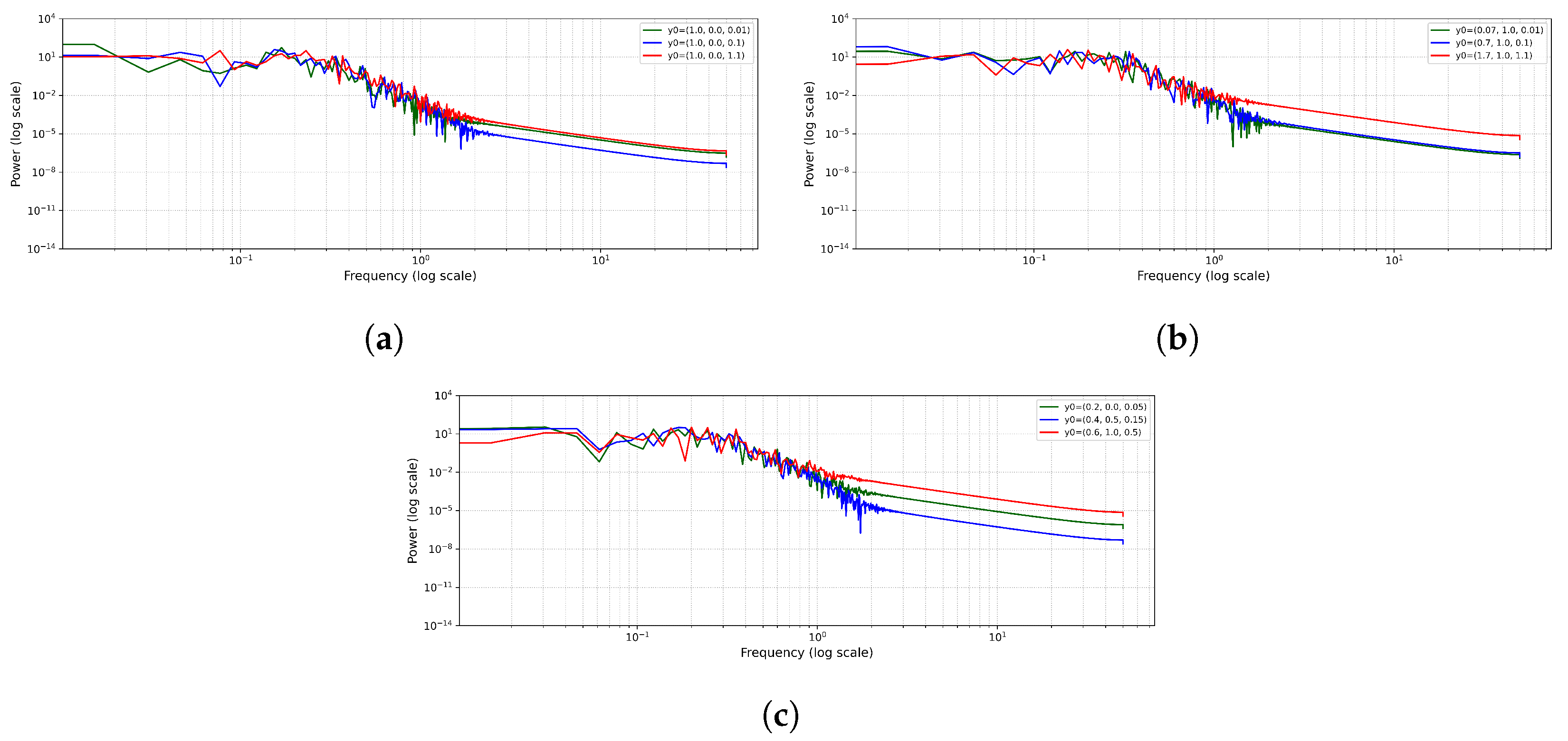
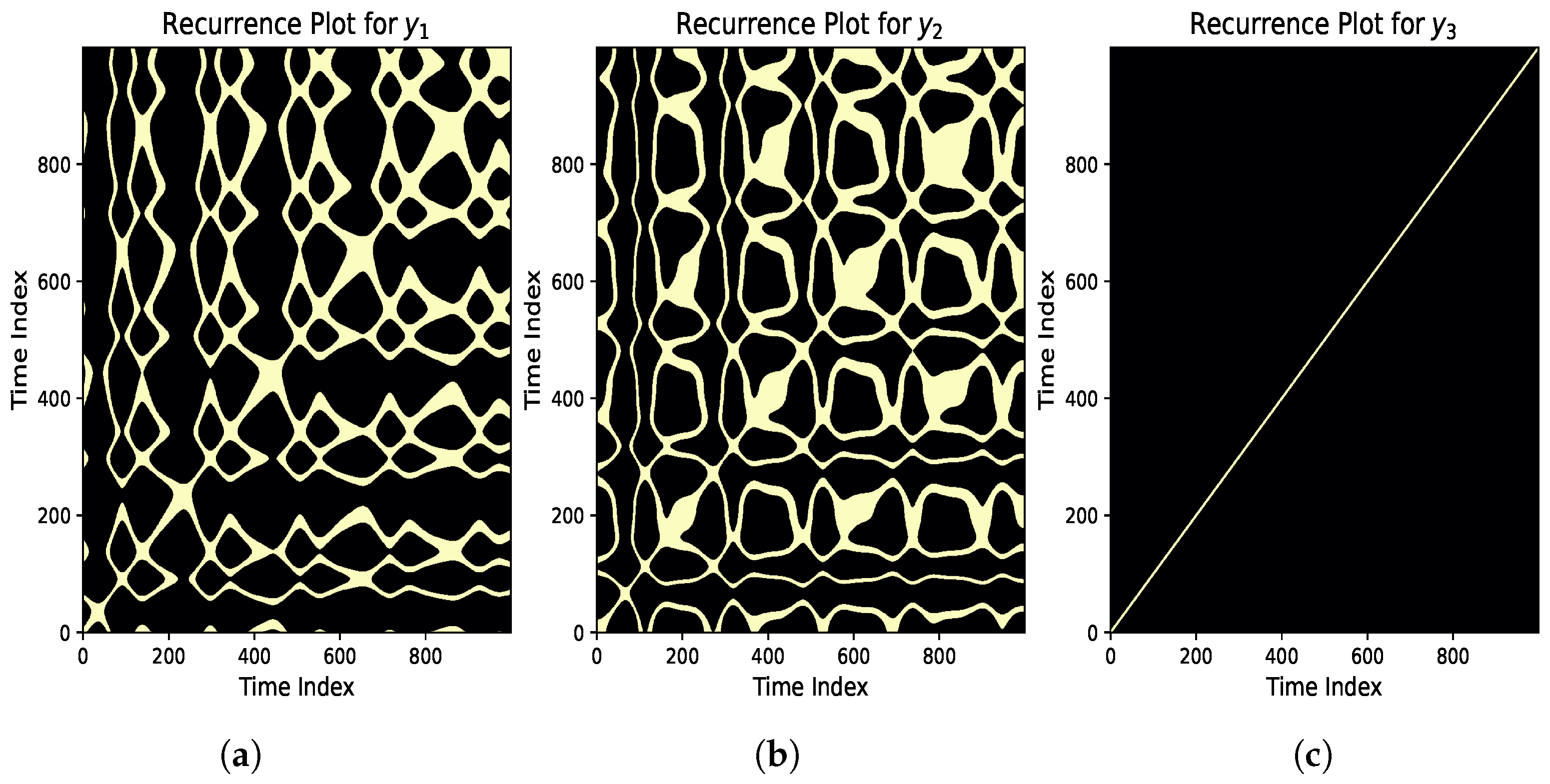
| Parameter (Symbol) | Observed Dynamics | Interpretation |
|---|---|---|
| Displacement (Z) | Varies with system response | System state variable representing position |
| Damping () | Limits oscillation amplitude, affects stability | Energy dissipation; influences limit cycles and routes to chaos |
| Linear stiffness () | Defines natural frequency | Base linear restoring force |
| Excitation amplitude () | Can induce parametric resonance | Strength of time-periodic stiffness modulation |
| Excitation frequency () | Controls timing of parametric excitation | Rate of stiffness modulation |
| Cubic nonlinearity () | Causes hardening/softening, jump phenomena | Duffing-type effect: frequency hysteresis, multi-stability |
| Quintic nonlinearity () | Adds further complexity, more equilibrium points | Higher-order restoring force, enhanced multi-stability |
| Term | True Coefficient | Identified Coefficient | Percent Error |
|---|---|---|---|
| −1.0 | −0.9801 | 1.99% | |
| −0.2 | −0.1696 | 15.2% | |
| −0.1 | −0.1092 | 9.2% | |
| −0.01 | −0.0012 | 88.0% | |
| 1.0 | 0.9480 | 5.2% | |
| 0.0 | −0.0142 | – |
| Damping Coefficient () | Approximate Onset of Chaos () |
|---|---|
| 0.10 | ≈1.8 |
| 0.15 | ≈1.8 |
| 0.20 | ≈3.0 |
| 0.25 | ≈3.2 |
| 0.30 | ≈3.4 |
| 0.35 | ≈3.6 |
| Figure | Parameters | Fixed Initial Condition | Initial Grid Range |
|---|---|---|---|
| (a) | = 0.0003, = 4.0, = 8.0, = 5.5, = 4.5, = 0.07 | = 0 | , |
| (b) | = 0.00025, = 4.2, = 9.0, = 5.8, = 5.0, = 0.06 | = 0 | , |
| (c) | = 0.00035, = 3.8, = 10.0, = 6.0, = 4.0, = 0.08 | = 0 | , |
| (d) | = 0.0004, = 4.1, = 9.5, = 6.2, = 4.8, = 0.09 | = 0 | , |
| (e) | = 0.0002, = 4.3, = 11.0, = 6.5, = 5.2, = 0.05 | = 0 | , |
| (f) | = 0.0003, = 4.4, = 10.5, = 6.8, = 5.5, = 0.04 | = 0 | , |
Disclaimer/Publisher’s Note: The statements, opinions and data contained in all publications are solely those of the individual author(s) and contributor(s) and not of MDPI and/or the editor(s). MDPI and/or the editor(s) disclaim responsibility for any injury to people or property resulting from any ideas, methods, instructions or products referred to in the content. |
© 2025 by the authors. Licensee MDPI, Basel, Switzerland. This article is an open access article distributed under the terms and conditions of the Creative Commons Attribution (CC BY) license (https://creativecommons.org/licenses/by/4.0/).
Share and Cite
Infal, B.; Jhangeer, A.; Muddassar, M. Algorithmic Investigation of Complex Dynamics Arising from High-Order Nonlinearities in Parametrically Forced Systems. Algorithms 2025, 18, 681. https://doi.org/10.3390/a18110681
Infal B, Jhangeer A, Muddassar M. Algorithmic Investigation of Complex Dynamics Arising from High-Order Nonlinearities in Parametrically Forced Systems. Algorithms. 2025; 18(11):681. https://doi.org/10.3390/a18110681
Chicago/Turabian StyleInfal, Barka, Adil Jhangeer, and Muhammad Muddassar. 2025. "Algorithmic Investigation of Complex Dynamics Arising from High-Order Nonlinearities in Parametrically Forced Systems" Algorithms 18, no. 11: 681. https://doi.org/10.3390/a18110681
APA StyleInfal, B., Jhangeer, A., & Muddassar, M. (2025). Algorithmic Investigation of Complex Dynamics Arising from High-Order Nonlinearities in Parametrically Forced Systems. Algorithms, 18(11), 681. https://doi.org/10.3390/a18110681







